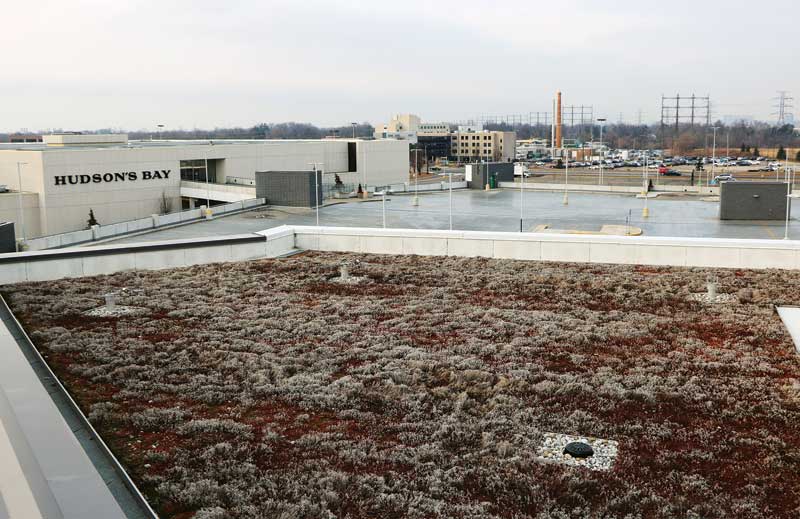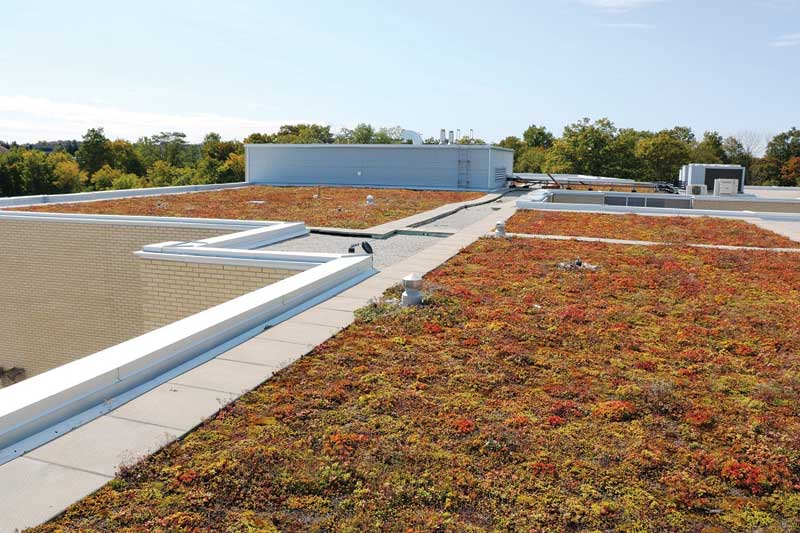Designing vegetated roofs to survive winter

Fall and spring maintenance
Year-round maintenance is key to ensuring long-term survivability as well as the stormwater performance of vegetated roofs. One last maintenance check should be done in the autumn as part of the yearly routine. Vegetated roofs are also known for their ability to protect the underlying roof membrane. However, circumventing maintenance and not taking proper preventative measures can lead to unforeseen problems.
Autumn maintenance must include removal of debris and inspection of all drainage paths. Large commercial and residential high-rise flat roofs, especially those with parapet walls, are catchalls for debris, including leaves, twigs, and plastic bags. In addition to potentially damaging the building, blocked drains and pooling water can cause the roots to rot and the plants to drown, leading to the failure of green roofs. Regular inspections can avoid costly repairs in the future. (For more information, refer to the 2013 Roofing Preventative Maintenance Manual by Canadian Roofing Contractors’ Association [CRCA].)
In autumn, it is best to remove fallen leaves and twigs from the green roof. Thick layers of leaves and twigs can also stick together to form an impenetrable mat and may lock in too much moisture, potentially causing rot or damage to the plants.
One must weed before winter sets in. Every effort must be taken to capture the seed pod intact. It must be tucked away for disposal to avoid blowing away seeds. Some weeds may be tolerated. Therefore, maintenance personnel should be familiar with green roof plants and the owner’s esthetic preference for the roof.
Keeping the vegetated roof hydrated in the autumn months helps the vegetation avoid winter’s freeze-drying effect, which is caused by low temperatures and high winds.
If there is an irrigation system, it needs to be winterized around October as frost typically sets in soon after in many Canadian cities. (Visit www.plantmaps.com for frost and hardiness maps.) Maintenance crews typically use an air compressor to blow out the water from the irrigation system.

On ground-level, perennials tend to be cut back. On the rooftop, however, tall grasses or wildflowers are ideally cut back the following spring. This encourages re-seeding and the stalks protect bees and other fauna during winter. Snow-covered stalks also offer a pleasing visual esthetic.
Extensive vegetated roofs require a minimal amount of slow-release fertilizer, which is best applied once, ideally in the spring at an application rate of 80 g (2.8 oz) per m2. This allows the plants to uptake most of the nutrients without much excess to go into the runoff. Over-fertilization can also cause plants to burn.
Slow-release fertilizer should not be employed on vegetated roofs after August because they may stimulate growth, compromising the plant’s hardiness. Left-over fertilizer should be discarded, or if the shelf-life extends another year, stored properly for the following spring.
Owners must assess the green roof’s performance in the autumn and prepare for spring. It is a good idea to document the visit with photos and record weather conditions for future reference as well as potential warranty claims.
In cold climates, particularly when temperatures drop below 0 C (32 F), foot traffic over vegetation must be avoided as it can prove lethal and leave foot-shaped patches of dead plants. The damage will be obvious in the spring. Recovery may take several months or may not happen at all. If pedestrian traffic is unavoidable, protective measures must be taken to diminish the impact of damage. Materials like plywood sheets and insulation boards may be laid over the vegetation temporarily to help distribute the weight on the green roof, and removed at the end of each day to allow plants to recover.
Finally, as maintenance workers may make frequent, short visits to vegetated roofs throughout the year, it is important they have appropriate working-at-heights training to conduct the work safely. In Canada, any person working at elevations is required by provincial law to be trained in fall protection. In the absence of appropriate parapets, or a permanent rail system, permanent or temporarily installed roof anchors are crucial to protect maintenance workers. Designing and building vegetated roofs with height safety in mind and providing workers with the necessary training is crucial to prevent falls from rooftops and subsequent death or serious injury.
Conclusion
In cold climates such as Canada, properly designed vegetated roofs, installed with hardy and mature plants that are well hydrated before winter, have a good probability of survival. If in the following spring, there is evidence of damage—caused by extreme temperature fluctuations, erosion due to high winds, or plant desiccation because of foot traffic—a basic repair is possible to help these sections quickly recover.
Cristina Senjug serves as communications manager at Next Level Stormwater Management. In addition to researching and writing articles, she organizes vegetated roof tours and technical and educational seminars for designers, engineers, and installers. Senjug can be reached at cristina@nlsm.ca.


